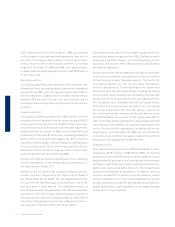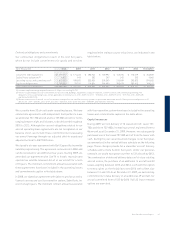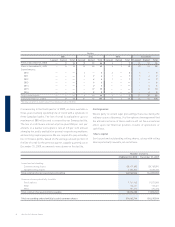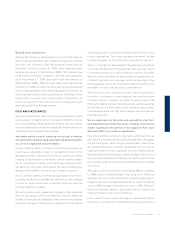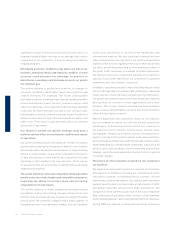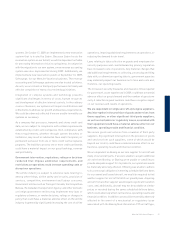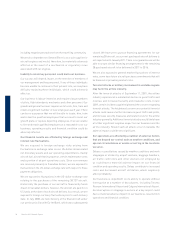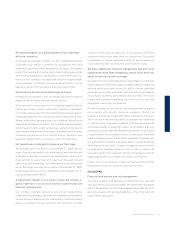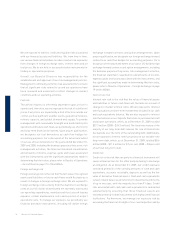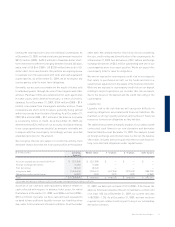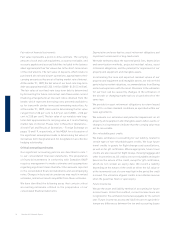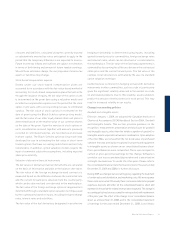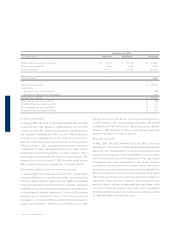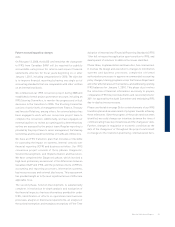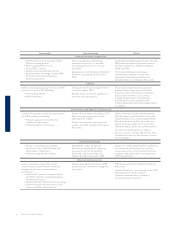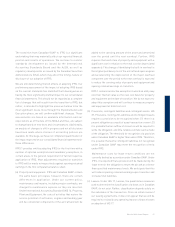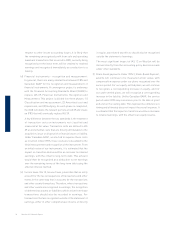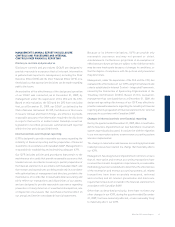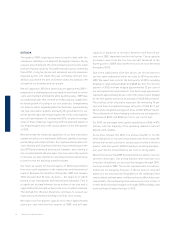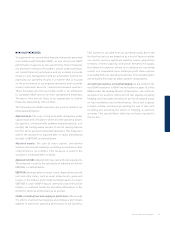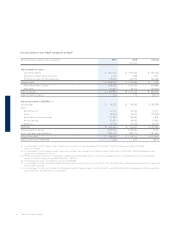Westjet 2009 Annual Report Download - page 62
Download and view the complete annual report
Please find page 62 of the 2009 Westjet annual report below. You can navigate through the pages in the report by either clicking on the pages listed below, or by using the keyword search tool below to find specific information within the annual report.
32 WestJet 2009 Annual Report
Depreciation and amortization, asset retirement obligations and
impairment assessments of long-lived assets
We make estimates about the expected useful lives, depreciation
and amortization methods, projected residual values, asset
retirement obligations, and the potential for impairment of our
property and equipment and intangible assets.
In estimating the lives and expected residual values of our
property and equipment and intangible assets, we rely on third
party industry market valuations, recommendations from Boeing
and actual experience with the asset. Revisions to the estimates
for our fleet can be caused by changes in the utilization of
the aircraft or changing market prices of used aircraft of the
same type.
We provide for asset retirement obligations to return leased
aircraft to certain standard conditions as specifi ed within our
lease agreements.
We evaluate our estimates and potential impairment on all
property and equipment and intangible assets when events or
changes in circumstances indicate that the carrying value may
not be recoverable.
Non-refundable guest credits
We make estimates in accounting for our liability related to
certain types of non-refundable guest credits. We issue future
travel credits to guests for fl ight changes and cancellations,
as well as for gift certifi cates. Where appropriate, future travel
credits are also issued for fl ight delays, missing baggage and
other inconveniences. All credits are non-refundable and expire
based on the nature of the credit, except for gift certifi cates,
which do not contain an expiry date. We record a liability
depending on the nature of the credit at either the full value or
at the incremental cost of a one-way fl ight in the period the credit
is issued. The utilization of guest credits is recorded as revenue
when the guest has fl own or upon expiry.
Future income tax
We use the asset and liability method of accounting for future
income taxes. Under this method, current income taxes are
recognized for the estimated income taxes payable for the current
year. Future income tax assets and liabilities are recognized for
temporary differences between the tax and accounting bases
Fair value of financial instruments
Fair value represents a point-in-time estimate. The carrying
amount of cash and cash equivalents, accounts receivable, and
accounts payable and accrued liabilities included in the balance
sheet approximate their fair values due to the short-term nature
of the instruments. The fair value of deposits, which relate to
purchased aircraft and airport operations, approximates their
carrying amounts as they are at a fl oating market rate of interest.
At December 31, 2009, the fair value of our fi xed-rate long-term
debt was approximately $1,323.1 million (2008 – $1,515.5 million).
The fair value of our fi xed-rate long-term debt is determined
by discounting the future contractual cash fl ows under current
fi nancing arrangements at discount rates obtained from the
lender, which represent borrowing rates presently available to
us for loans with similar terms and remaining maturities. As
at December 31, 2009, rates used in determining the fair value
ranged from 2.28 per cent to 3.27 per cent (2008 – 2.08 per
cent to 2.58 per cent). The fair value of our variable-rate long-
term debt approximates its carrying value as it is at a fl oating
market rate of interest. Please refer to Results of Operations –
Aircraft Fuel and Results of Operations – Foreign Exchange on
pages 15 and 19, respectively, of this MD&A for a discussion of
the signifi cant assumptions made in determining fair value of
derivatives both designated and not designated in an effective
hedging relationship.
Critical accounting estimates
Our significant accounting policies are described in note 1
to our consolidated financial statements. The preparation
of financial statements in conformity with Canadian GAAP
requires management to make estimates and assumptions
regarding signifi cant items that affect the amounts reported
in the consolidated fi nancial statements and accompanying
notes. Changes in facts and circumstances may result in revised
estimates, and actual results may differ from these estimates.
We have identified the following areas that contain critical
accounting estimates utilized in the preparation of our
consolidated fi nancial statements:


